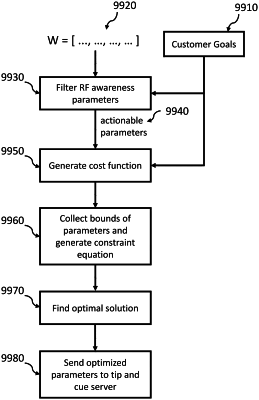| CPC H04W 16/10 (2013.01) [H04W 24/02 (2013.01); H04W 24/08 (2013.01); H04W 28/0925 (2020.05); H04W 28/0967 (2020.05); H04W 72/0453 (2013.01); H04W 16/14 (2013.01)] | 16 Claims |

|
1. A system for optimization of spectrum utilization in an electromagnetic environment, comprising:
at least one monitoring sensor operable to monitor the electromagnetic environment and to create measured data;
at least one data analysis engine operable to analyze the measured data to create analyzed data, including radiofrequency (RF) awareness parameters; and
at least one server configured to enable communication over a network;
at least one smart contract engine;
at least one detection engine operable to perform automatic signal detection;
at least one interference mitigation engine operable to use analyzed data to identify interference between at least two wireless signals transmitted on overlapping frequency bands; and
at least one multi-network orchestration module operable to manage simultaneous operation of at least two wireless networks that contain the at least two wireless signals;
wherein the at least one multi-network orchestration module coordinates allocation of spectrum resources for the at least two wireless networks;
wherein the at least one detection engine is operable to create a mask by analyzing the measured data over time;
wherein the at least one detection engine is operable use the mask to highlight at least one unexpected signal to further identify the interference between the at least two wireless signals;
wherein the at least one interference mitigation engine uses a machine learning algorithm to predict interference patterns based on the analyzed data and dynamically adjust signal parameters based on the interference between the at least two wireless signals and the predicted interference patterns to mitigate the interference between the at least two wireless signals;
wherein the at least one smart contract engine is operable to utilize blockchain technology to facilitate dynamic spectrum leasing and sharing between at least two telecommunication operators; and
wherein the at least one smart contract engine allocates spectrum based on traffic load, signal quality, and financial terms.
|